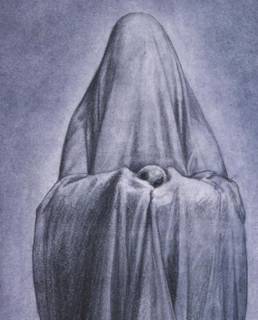Death Faery

She is, perhaps, the most feared of all faeries. The Irish know her as the banshee, a faery woman who keens and wails in the night, fortelling death. In Scotland, she´s the Washer at the Ford, washing the grave clothes of those about to die. Her shadowy figure appears to each one of us at some point in our lives, bearing an irresistible summons from another world.
Sometimes we can refuse the call for a while, but eventually we must follow. She holds out a vision of our past. Does it shine with joy? Or is it clouded by too many things we neglected to do? It’s too late to make changes now. The Death Faery awaits, ready to lead us into a future of our own making. Now is the dreaded moment. We must take her hand. It’s time to go.
Brian Froud – Good Faeries/Bad Faeries
Sometimes we can refuse the call for a while, but eventually we must follow. She holds out a vision of our past. Does it shine with joy? Or is it clouded by too many things we neglected to do? It’s too late to make changes now. The Death Faery awaits, ready to lead us into a future of our own making. Now is the dreaded moment. We must take her hand. It’s time to go.
Brian Froud – Good Faeries/Bad Faeries




2 Comments:
Eu nunca soube ao certo o que era uma banshee, tinha a idéia de que era uma espécie de objector de consciência(ou seja cada um tinha a sua banshee)...está muito interessante, essa informação está em algum site?
Cumprimentos
Luís
Olá Luís, em resposta à tua questão, encontrei uma definição da Banshee. Passo a transcrever:
"The banshee , from ban (bean), a woman, and shee ( sidhe, a fairie), is an attendant fairy that follows the old families, and none but them, and wails before a death. Many have seen her as she goes wailing and clapping her hands. The keen (caoine), the funeral cry of the pesantry, is said to be an imitation of her cry. When more than one banshee is present, and they wail and sing in chorus, it is for the death of some holy or great one. An omen that sometimes accompanies the banshee is the _coach-a-bower_ (coiste-bodhar), an immense black coach, mounted by a coffin, and drawn by headless horses driven by a _Dullahan_. It will go rumbling to your door, and if you open it, according to Croker, a basin of blood will be thrown in your face. These headless phantoms are found elsewhere than in Ireland. In 1807 two of the sentries stationed outside St. James's Park died of fright. A headless woman the upper part of her body naked, used to pass at midnight and scale the railings. After a time the sentries were stationed no longer at the haunted spot. In Norway the heads of corpses were cut off to make their ghosts feeble. Thus came into existence the _Dullahans_, perhaps ; unless, indeed, they are descended from that Irish giant who swam across the Channel with his head in his teeth.
(from "A Treasury of Irish Myth, Legend, and Folklore", Ed. W.B. Yeats)"
Post a Comment
<< Home